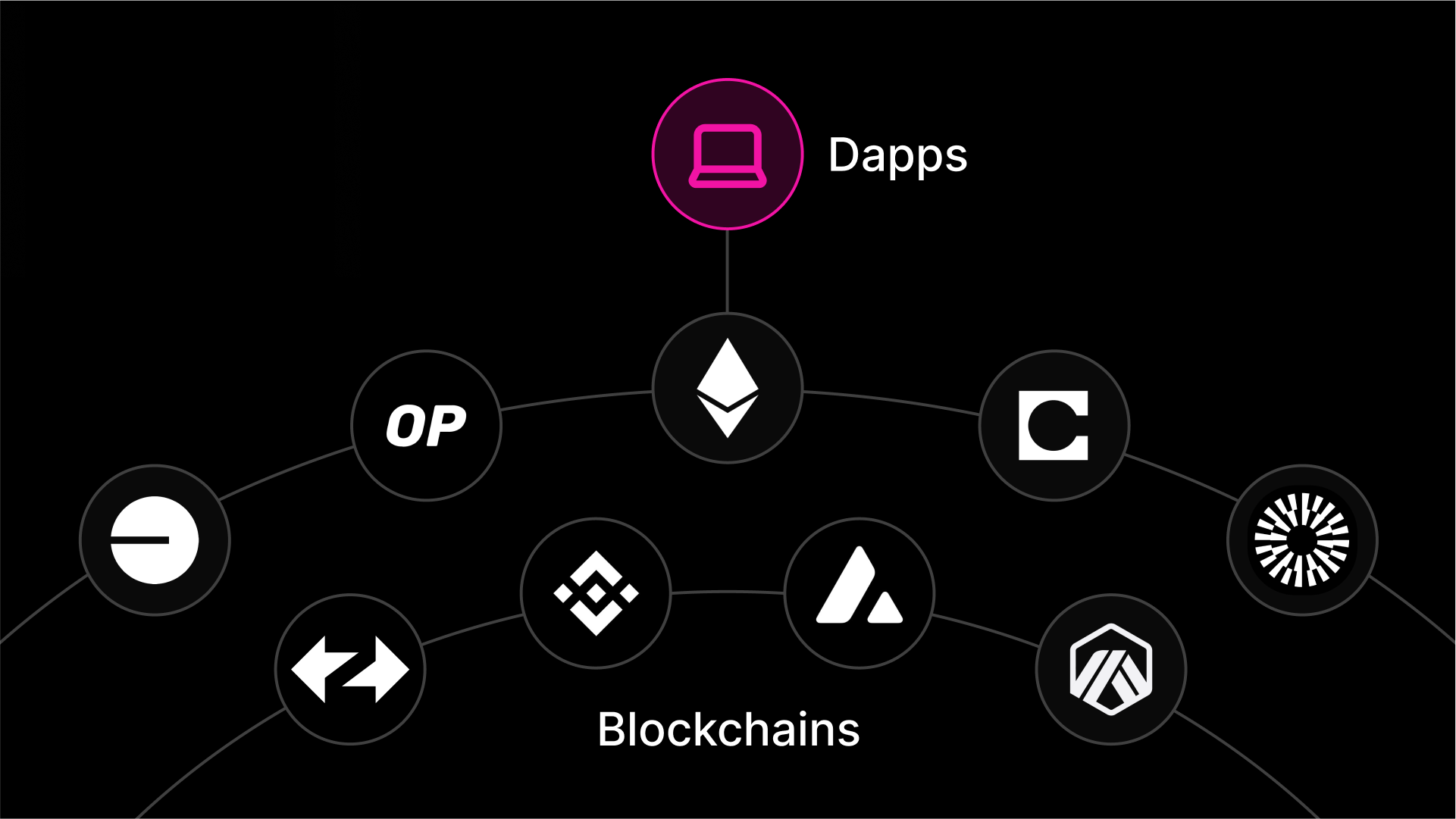What is Chain Abstraction?

Navigating Web3 as a developer often feels like being a sysadmin trapped in a cryptographic maze. While we’ve come a long way, today, there are still some significant roadblocks on the path to crypto mass adoption, namely user-experience. Liquidity pools splintered across multiple chains, the overheads of maintaining bridge security, and hitting gas token roadblocks are just the beginning. This fragmentation isn’t just annoying—it’s costing protocols real money.
Enter chain abstraction: a concept designed to simplify and unify interactions across various blockchains. By abstracting the underlying complexities, chain abstraction enables users to engage with dApps —without needing to comprehend the intricacies of each blockchain involved.
The idea is to remove the complexity of the blockchain away from the end-user, much like TCP/IP abstracted physical network layers. And today, a few different projects aim to do exactly that.
But before we get there, let’s dive into what chain abstraction really is.
What is Chain Abstraction?
Chain abstraction is the process of removing the complexities and technicalities associated with interacting with multiple blockchain networks, thereby enhancing the overall user experience. In essence, it allows users to engage with decentralized applications without needing to be aware of the specific blockchains they are interacting with. This means that the underlying blockchain technology becomes invisible to the user, providing a more seamless and intuitive experience
By unifying different blockchains under a single interface, chain abstraction eliminates the need for users to manage multiple wallets, accounts, and gas tokens. This simplification not only enhances user experience but also addresses the fragmented nature of the current blockchain ecosystem.
The History of Chain Abstraction
As the number of blockchains increased, each with its unique protocols and functionalities, the complexity for both users and developers has only escalated. As the ecosystem has grown, so too has the fragmentation, leading to isolated liquidity, inconsistent user experiences, and barriers to interoperability.
Recognizing these challenges, the blockchain community began exploring solutions to abstract the underlying complexities of multiple chains. The goal of chain abstraction is simple: to create a unified experience that would allow users to interact with decentralized applications seamlessly— regardless of the specific blockchains involved.
What is Chain Abstraction For?
Chain abstraction simply removes the stresses of fragmentation, but let’s explore why that’s important:
Enhanced User Experience
By abstracting the complexities of multiple blockchains, users can interact with decentralized applications without needing to understand the underlying technologies. Users transact across chains without manual bridging or network switching, bringing Web3 tech to a broader audience.
Improved Interoperability
Chain abstraction facilitates seamless communication between different blockchains; allowing assets and data to move freely across networks. This interoperability is crucial for the growth and integration of decentralized applications.
For developers looking to expand their reach, chain abstraction improves interoperability by enabling cryptographic proofs to authenticate transactions across multiple chains. This allows dApps to interact with various blockchains and reach a wider user base.
Simplified Development
With chain abstraction, you can build applications without the constraints or limitations of a specific blockchain. This flexibility enables the creation of more versatile and robust applications that can operate across multiple networks. Furthermore, pre-configured tools and intent frameworks simplify cross-chain transactions and gas fee processing, accelerating dApp deployment
Cost-Efficiency
Additionally, chain abstraction allows for cost-efficient operations. The use of intermediaries that front liquidity and charge fees helps reduce costs compared to traditional cross-chain bridges. Unified liquidity pools further reduce fragmentation, making liquidity accessible across chains without locking up funds.
How Does Chain Abstraction Work?
Chain abstraction functions through a technical stack comprising three distinct layers: intent signaling, unified settlement, and gas abstraction. These layers work together to remove the complexity of multi-chain interactions, ensuring a seamless experience for both developers and users.
Intent Signaling
Intent signaling allows users to specify their desired outcomes without needing to understand the underlying blockchain mechanics. Rather than specifying exact chains or transaction paths, users simply declare their intent, and the system automatically determines the best route for execution.
For example, THORChain uses slip-based limits to route swaps through the most liquid chain pairs, optimizing for efficiency and minimizing slippage. By abstracting the routing process, users can achieve their intended results without manual intervention.
Unified Settlement
Once an intent is signaled, a coordination layer processes and decomposes the intent into chain-specific actions. This may be executed through a decentralized network or smart contract framework that ensures all actions align across multiple blockchains.
LayerZero’s Endpoint contracts exemplify this mechanism by validating proofs from other chains through on-chain light clients. This approach ensures trust-minimized cross-chain interactions, allowing assets and data to move seamlessly across networks.
Gas Abstraction
Gas abstraction eliminates the need for users to manage multiple blockchain-native tokens to cover transaction fees. Instead, users can pay fees in a single token—or have them entirely subsidized by developers.
NEAR’s “keypom” SDK allows developers to sponsor gas fees, enabling users to sign meta-transactions without holding NEAR tokens. This removes a significant friction point for onboarding new users into Web3 applications.
Real-World Applications and Projects
DeFi Yield Platform Maverick Protocol
Maverick Protocol leverages LayerZero to allow liquidity providers to deposit assets on Ethereum while earning yield on zkSync, abstracting away the complexities of cross-chain liquidity provisioning.
Decentralized Exchange dYdX
dYdX V4 migrated its order book to Cosmos while settling trades on Ethereum, reducing gas costs by 90% and improving trade execution efficiency.
Web3 Gaming: Shrapnel
Shrapnel, a first-person shooter game built on Avalanche, integrates Particle Network to enable seamless NFT purchases on Polygon using Arbitrum ETH balances. This cross-chain abstraction allows gamers to transact without manually bridging assets between blockchains.
Digital identity: Lit Protocol
Lit protocol uses LayerZero to implement decentralized identity verification, allowing users to prove ownership of digital assets across different chains without exposing their private keys.
Top Chains Leveraging Chain Abstraction
Several platforms have emerged as leaders in implementing chain abstraction, each offering unique approaches to simplifying multi-chain interactions and improving user experience across decentralized applications.
NEAR Protocol
NEAR provides services that allow developers to create and recover accounts using email addresses, use accounts without acquiring funds, and control accounts across multiple chains. This approach aims to abstract blockchain technology away from the user experience, making it more accessible. NEAR’s FastAuth feature further enhances usability by enabling passwordless authentication, streamlining onboarding for new Web3 users.
Particle Network
Particle Network focuses on an account-based approach to chain abstraction, aiming to remove user experience frictions associated with managing multiple blockchains. Simply, it enables users to leverage their wallet balances across multiple chains as if they were unified on one, enhancing interoperability and user experience.
LayerZero
LayerZero is an omnichain interoperability protocol that connects different blockchain networks by providing a lightweight cross-chain messaging framework. At its core: the Omnichain Fungible Token (OFT) standard. This allows tokens the native transfer of assets across multiple chains—without the need for multiple bridges.
Additionally, LayerZero’s Ultra Light Nodes (ULNs) enable efficient and secure verification of cross-chain transactions, ensuring that interactions remain trust-minimized and decentralized.
THORChain
THORChain is a decentralized liquidity protocol that enables native cross-chain swaps without the need for wrapped assets. Unlike traditional cross-chain solutions that rely on synthetic assets or custodians, THORChain facilitates direct asset swaps across multiple blockchains while maintaining full decentralization.
By leveraging an automated market-making (AMM) system, THORChain provides deep liquidity pools that optimize asset swaps and reduce price slippage to foster a better user experience.
Challenges of Chain Abstraction
Of course, not everything is plain sailing when you’re trying to marry multiple chains: there are some challenges involved.
Security Concerns
Introducing an abstraction layer may present additional security challenges. Ensuring the integrity and security of transactions across multiple blockchains requires robust protocols and continuous monitoring.
Complex Implementation
Developing and maintaining the infrastructure necessary for chain abstraction can be complex. It requires a deep understanding of multiple blockchains and the creation of systems that can manage interactions between them effectively.
Potential for Centralization
Reliance on intermediaries, such as relayers, could introduce centralization risks. It's essential to design these systems in a way that maintains the decentralized nature of blockchain technology.
What’s the Difference Between Chain Abstraction and Account Abstraction?
While chain abstraction and account abstraction may sound similar, they serve different purposes in the blockchain ecosystem.
Chain Abstraction refers to the ability to interact with multiple blockchains seamlessly without needing to be aware of their underlying complexities. It unifies the user experience across different chains.
Account Abstraction focuses on making blockchain accounts more flexible and user-friendly by allowing smart contracts to manage accounts, removing the need for private keys for every action, and enabling features like gasless transactions.
Both concepts work towards simplifying blockchain interactions but address different layers of the user experience.
Chain Abstraction: Making Web3 Interactions Even More Seamless
As blockchain technology continues to evolve, chain abstraction represents a significant step toward making Web3 more user-friendly and accessible. By eliminating the complexities of interacting with multiple blockchains, this innovation paves the way for mass adoption and seamless decentralized application development.
For developers looking to build the next generation of decentralized applications, leveraging chain abstraction technologies can provide a competitive edge. Understanding and implementing these solutions will be crucial in creating a more integrated and efficient Web3 ecosystem.

